Grinling Gibbons
at Trinity College Chapel, Oxford
Martin Hall
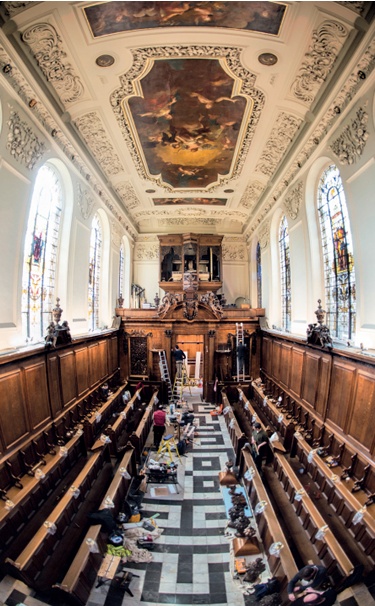 |
| Conservators at work on Grinling Gibbons’ screen which divides the antechapel from the nave (All photos: Bruce Hammersley) |
Trinity College was founded in 1555 by Sir Thomas Pope using the buildings of the former Durham College. The medieval chapel, consecrated in 1410, was retained, but by the late 17th century it was in a poor state of repair, its condition exacerbated by lack of maintenance during the Civil War.
When Ralph Bathurst became president of the college in 1664 he devoted himself to the restoration of Trinity’s fortunes. He cherished the dream of a new chapel for three decades. With great generosity, he paid for the building shell himself, while college records show that he wrote many letters to solicit funds to enable him to pay for the completion of the magnificent interior. The result was the current chapel. Completed in 1694, it was built largely on the footprint of the original chapel.
Letters reveal that Bathurst had assistance from Sir Christopher Wren who was consulted on the design at a late stage, but in time to influence the chapel’s external appearance and to give the parapets their distinctive flaming urns.
On entering the chapel today, the most striking feature is Grinling Gibbons’ magnificent screen which divides the antechapel from the nave. It features fluted Corinthian columns and an arched pediment, topped with carvings of the Evangelists, and has two fretwork panels either side, with putti (infant angels) at their centres.
Passing through the screen reveals the impressive reredos behind the altar, which was also designed by Grinling Gibbons and is considered to be one of the best examples of his work.
Above, the sumptuous ceiling is decorated with exquisitely carved and moulded plasterwork, thought to be heavily influenced by Gibbons and hand modelled, possibly by Bradbury and Pettifer or Edward Goudge, ‘the beste master in England in his profession’. At its centre is a painting, ‘Christ in Glory’, by Pierre Berchet, about eight metres long and set between two smaller painted panels.
The result was described by diarist Celia Fiennes, a pioneering and enthusiastic 17th-century traveller, as ‘a fine neate chapple new made finely painted… a Beautiful Magnificent Structure’.
Apart from several changes to the decoration over the centuries, the most significant alteration to the chapel was the replacement of the original clear glass windows with stained glass in the late 19th century, and the installation of successive organs, most recently in 1965 with a case by Stephen Dykes Bower in the Gothic Revival style. Major repairs to the roof and ceiling were carried out in the 1930s, and its eight stained glass windows were removed during the war for their protection. All but one of these were reinstated after the war. Research during the conservation work found this window to be from a German school of stained glass.
Plans for an extensive conservation project were conceived in 2010 following a quinquennial survey. Owing to the importance of the Grade I listed chapel, many experts were asked to give their opinions on the main internal features, including the carvings and woodwork, plasterwork, ceiling painting and stained glass windows. All confirmed the need for urgent repairs and conservation. This article focusses on the timber conservation elements of the programme that followed, and on the conservation of the Grinling Gibbons wood carvings in particular.
THE REREDOS AND THE EAST WALL
A condition report on the timber carvings, panelling and decorative works revealed that much of the oak panelling was in good order, but that the Grinling Gibbons carvings which form the pièce de résistance around the starburst panel above the altar were in need of careful conservation. There was also concern that the reredos panelling was set against a damp wall. Much of the stonework of the outer walls had been replaced in the 1960s to make good the decay caused by coal-fire pollution, but the east wall had not been re-faced.
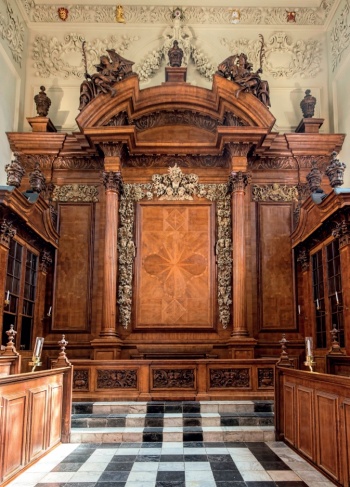 |
|
| The conserved reredos against the dried out east wall of the chapel |
An environmental monitoring survey was carried out by Brian Ridout of Ridout Associates to evaluate the level of damp and relative humidity. The evidence showed that moisture levels in the east wall were excessive, especially at its base. Fortunately for the important woodwork, conditions elsewhere in the chapel were found to be relatively benign.
It was decided to repair and conserve the existing stonework. A lime mortar was used to fill in any voids and a lime mortar shelter-coat was applied over the surface. At the same time, the ground level was lowered at the foot of the wall and a drainage trench (or ‘French drain’) filled with free-draining gravel was created to enable it to dry out.
Removing one of the small panels in the lower part of the reredos yielded an interesting discovery: the main parquetry panels are set on a pine backing panel, made up of vertical tongue-and-groove boards, with a layer of pitch coating the rear surface (which abuts the outer wall). This early precaution was made by the original carpenters and joiners to protect the screen and has been successful in keeping the woodwork in generally good condition.
THE REREDOS
Early on, the decision was taken to carry out detailed research to try to establish the original appearance of the different woodwork features of the reredos.
One of the most exciting outcomes has been confirmation that the carvings, in limewood, oak and exotic hardwood, are all the work of Grinling Gibbons. One of the most famous craftsmen of his era, Gibbons (1648-1721) was a carver of great skill in both wood and stone. He was born in Rotterdam and came to England in his youth, gathering experience and a growing reputation while in the employ of the architect Hugh May. Gibbons went on to work with Wren at St Paul’s Cathedral, where his most famous work can be seen in the carved ornament of the choir stalls and Bishop’s throne (1696-8). John Summerson describes Gibbons as having:
...an astonishing facility for naturalistic carving in soft woods which accounts for the universal and continued popularity of his creations. His aim, quite evidently, was to emulate the Dutch flower painters in his own medium, and he succeeded to a miracle. (Architecture in Britain 1530-1830, p238-9)
The richly-coloured central panel of the reredos is surrounded by contrasting, pale limewood carvings. These were found to be fixed crudely with clout-cut, handmade nails struck directly into the backing boards. After some effort and with extreme care, the carvings were removed by wood carvings conservator Alan Lamb and his team for condition assessment at their workshop.
Many areas had been so badly eaten away by common furniture beetle that they were composed more of voids than substance. These elements were consolidated using poly vinyl butyral in ethanol (2-3% in solution), which had been used successfully on other Gibbons limewood carvings.
Using mid-19th and early 20th-century photographs, Alan Lamb was able to determine which elements had been lost over time and a number of these were replaced. The decision on what to replace was generally guided by the ‘six-foot rule’: if it can’t easily be seen from six feet away, don’t replace it.
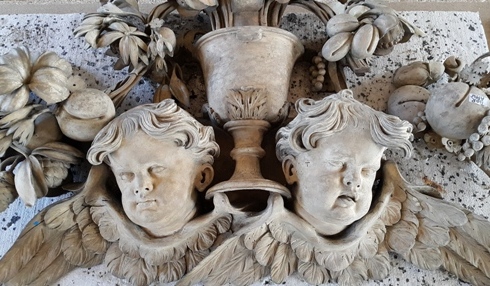 |
 |
|
| Limewood cherubs and chalice from the head of the reredos during cleaning | A lithograph of the interior c1840 |
After careful test cleaning and analysis of the layers of the varnish and paint it was discovered that for at least the first 50 years the carved limewood had been left undecorated. Having become very dirty and dusty, it had been given a ‘reviving’ coat of oil-based lead paint directly over the original surface finish (without even attempting to clean it, a layer of dirt was clearly visible under the first application of paint). This was an attempt to replicate the original appearance and colour of the limewood and since then it has been repainted several times.
Alan Lamb’s team cleaned off as much of the paint and varnish as possible without damaging the underlying wood, and recreated the most significant missing elements, leaving carvings that are now close to their original appearance.
THE SCREEN
The figures of the Evangelists, which rest on the pediment of the antechapel screen along with their symbols – a winged bull, an eagle, a winged lion and an angel – as well as the two Victories on the pediment of the reredos, are carved in oak and rare Bermudan cedar (Juniperus bermudiana). This type of cedar is no longer available because the trees are endangered, but fortunately one of the college’s generous donors found a small supply of old timber which enabled repairs to be carved from matching wood.
When the Evangelists were being reinstalled, Alan Lamb’s team encountered difficulty in fitting the eagle to the figure at the north east. On checking a 1914 photograph it was realised that the Evangelists at the north east and south west had been swapped sometime after this date. The beardless Evangelist (St John) has now been correctly replaced with his eagle, facing into the chapel.
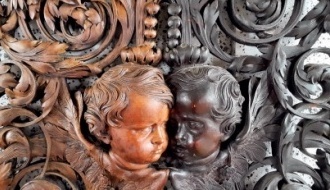 |
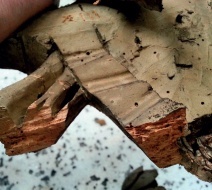 |
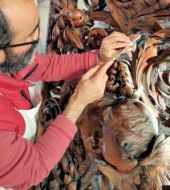 |
||
| Above left: the partially cleaned faces of putti from the antechapel screen. Thick varnish had been applied in the 1860s, obscuring fine detail in the Bermudan cedar carvings. Centre right: woodworm damage to reredos carvings. Right: conservator David Mendieta carving a repair to replace a missing leaf tip | ||||
The two magnificent pierced panels in the antechapel screen are also carved in Bermudan cedar. Thorough cleaning to reveal the original finish has shown them to be carved to an exceptionally high standard and, like the limewood, to be some of Grinling Gibbons’ best work.
Late Victorian photographs showed that these screens had previously faced the other way, which is how they have been reinstated: the putti now face outwards into the antechapel, as originally intended.
The pierced cedar panels and the figures on the pediment had been finished in a thick, dark varnish, obscuring the quality of the original carving. A key piece of research indicated that this dark scheme was a Victorian intervention. In 1867, following a visit to Trinity, Mr WG Rogers presented a paper to the Royal Institute of British Architects in which he noted:
When I was there, I complained to the verger that I could not make out the faces of the angels on the altar pediment, but when I put my hand on the open worked panels, I found they had been painted over with a thick oil darkened with Vandyke brown as sticky and moist as if it had been done over less than a week ago.
Since even unboiled linseed oil would have dried within a couple of months, Rogers’ account helped to establish the date of the dark varnish quite accurately and corroborated the analysis of the varnish report.
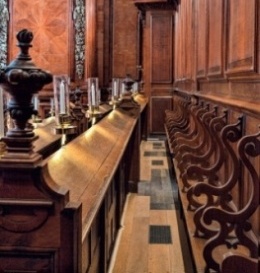 |
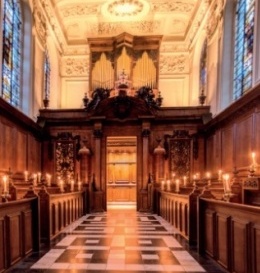 |
|||
| Above left: repairs to the raised floor below the pews with a mix of new European oak boards and sections of salvaged originals. Above right: new LED light pads beneath the candle-holders provide additional lighting. | ||||
Many of the chapel’s important wood carvings had retained this dark finish for 150 years, so ‘winding the clock back’ to before the Victorian intervention was a drastic proposal.
However, the combination of the varnish analysis and historical research convinced the college and the diocesan advisory committee to allow the carvings to be returned to the appearance that Grinling Gibbons and Bathurst intended.
As much of the dark varnish as could safely be removed was lifted to reveal the carvings beneath in their original glory.
In the process of cleaning the woodwork, the restorers were able to discern the marks of the different carvers, adding greatly to the understanding of how Grinling Gibbons’ workshop carried out the work.
OTHER WORKS
The north and south walls are lined with oak panelling as a backdrop to the fixed stalls and pews facing towards the aisle. These too had been over-waxed, stained and polished. They were cleaned back to remove the layers of wax and repaired at the same time.
The supports to the raised floors beneath the pews had deteriorated over time and many were supported on pieces of brick and timber. The main oak bearers had disintegrated, mainly from dampness and death watch beetle. The floor structure was removed entirely then carefully reconstructed, reusing original material where possible.
The ceilings were carefully cleaned and missing elements of plasterwork were restored by Cliveden Conservation.
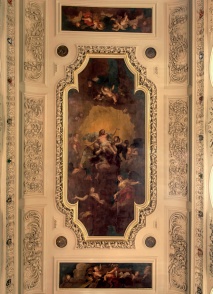 |
|
| Detail of the ceiling paintings and plasterwork after cleaning and revarnishing |
Because repairs to the ceiling paintings had been so crudely executed in the past, it was not realistically possible to revert to the original paintwork. It was therefore decided to clean the old varnish off and re-varnish. A matt finish was chosen because movement in the past had resulted in an uneven surface, and the reflections from the old glossier varnish had been distracting. This has enabled a better view of the paintings.
A new lighting scheme was essential because the main light sources were 500W halogen lamps which sat crudely above the timber cornices and constituted a fire hazard. Designed by church-lighting specialist Mark Sutton Vane Associates, the new scheme includes modern LED lighting, much of which highlights particular features and has transformed the internal appearance of the chapel.
The stained glass windows were carefully cleaned by the York Glaziers Trust using small cotton wool swabs, and the German window, which had been left in an attic since the second world war, was reinstated.
Although the glass was in good condition, the painted surfaces of the coloured glass were felt to be too fragile to expose to the elements. The existing (plain) outer window, installed after the window was removed in the 1940s, has therefore been retained to act as a protective shield, with the restored stained glass located inside it, with its own sub-frame. This method of isothermal glazing was developed by the York Glaziers Trust and has been used by them to similar effect in York Minster.
RE-OPENED AND RESPLENDENT
Following one of the most comprehensive conservation and cleaning programmes it has ever undergone, the Grade I listed chapel re-opened in April 2016. After a year’s closure and a great deal of painstaking work, it is once again resplendent.
Over 50 craftspeople were involved in this major project, which is probably the most significant and wide-ranging work to be undertaken on the chapel since its construction. The project has captured the imagination of all of those who have worked on it and their contributions have widened our understanding of Trinity’s best-known and most fascinating building. The project has been honoured by the local Oxford Preservation Trust and commended by the Georgian Society.



